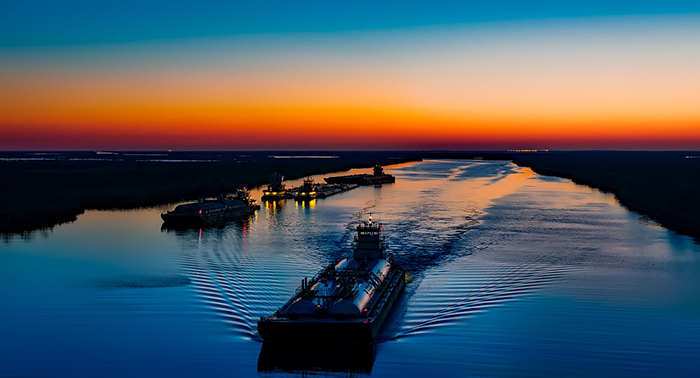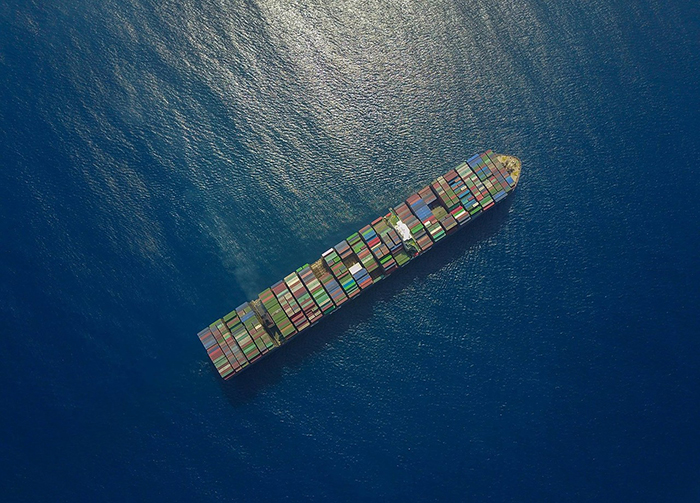Maritime Autonomous Surface Ships
December 10, 2019
It would not be that far in the future to have autonomous ships for freight transportation coming into the world. In the logistics industry, autonomous cars or automation of warehouse operations have been hot topics in recent years. But the wave of automation is also coming to the ocean freight transportation industry on a much larger scale. The autonomously operated ship, commonly called Maritime Autonomous Surface Ships (MASS), was still a dream story in the field of freight transportation 10 years ago. However, it might be no longer a dream with technology development and specific actions towards practical application in process.

As for autonomously operated vessels specializing in freight transportation, a fertilizer company and a marine system provider in Norway have started to develop autonomously operated and fully electrified vessels in 2017(*1). This ship will be a container feeder ship that can carry 120 TEU to transport fertilizers for a short distance between ports. After some operational tests with a smaller number of crews, this project aims for the ship to be fully autonomous in 2022 (the ship is unmanned and controlled from the shore control center). Furthermore, in this project, automation of port handling and electrification of the entire port are being considered together. This project has become famous as the world's first autonomous ship project for logistics.
While the MASS project has progressed in Europe, significant results have recently been reported in Japan, too. In October 2019, a Japanese shipping company succeeded in an automatic operation test using an optimal navigation program for a large-sized car carrier. It has drawn attention as it was a first global demonstration case based on the "Interim guidelines for trials of autonomous ships" prepared by the International Maritime Organization (IMO), the global regulatory body for international shipping. In this experiment, while maintaining the normal number of crews, the installed program grasped the surrounding situation based on the data from the navigation instrument, calculated the collision risk, determined the optimum route, and then automatically operated the ship. The operation was carried out in the actual sea, and the operational situation was monitored and evaluated. This experiment was conducted with the aim of future "manned autonomous ship operation."

So why do we need autonomous ships? First, it is for safety. Under the premise that humans make mistakes, it is thought that safety can be enhanced by automation without human intervention. The second point is to deal with the shortage of personnel. Young people are not willing to become pilots of coastal vessels, and it is predicted that there will be a shortage of coastal ship crews in the future. Both Europe and Japan seem to face the same labor shortage issue. Therefore, technology to supplement labor shortage would be effective. The third reason is to improve operational efficiency, which is also related to labor shortages. If it is possible to navigate the ship with a smaller number of crews, it leads to reduce investment on hard infrastructure of ships, such as reduction of accommodation space for crews as well as labor costs. As a result, it will contribute to improve the ship's operational efficiency.
Given such background, researches on MASS have progressed mainly in Europe, including the development of navigation systems, collision avoidance technology, obstacle detection technology, and situational analysis. All these technologies support decision-making to avoid risks. Then, the debate arises over who makes decisions and when such decisions are made. As the regulatory body, IMO has preliminary defined the degrees of autonomy in four stages for MASS(*2). This definition would apply for both passenger ships and cargo ships.
| Degree of Autonomy | Definition |
|---|---|
| Low | Ship with automated processes and decision support: Seafarers are on board to operate and control shipboard systems and functions. Some operations may be automated. |
| ↓ | Remotely controlled ship with seafarers on board: The ship is controlled and operated from another location, but seafarers on board. |
| ↓ | Remotely controlled ship without seafarers on board: The ship is controlled and operated from another location. There are no seafarers on board. |
| High | Furry autonomous ship: The operating system of the ship is able to make decisions and determine actions by itself. |
2.Source:IMO
http://www.imo.org/en/MediaCentre/PressBriefings/Pages/08-MSC-99-MASS-scoping.aspx
The definition of IMO is consistent with the history of ship automation. Ship automation and remote control have assisted crews on board to judge danger for ships. The next stage involves ships automatically operated without crews on board, but decisions are made by humans from the shore by remote control. This degree of autonomy has already been applied to small vessels such as surveillance vessels and research vessels. Whether crews are on board or not, it has been human beings who use the latest technology to make decisions. But nowadays, with the development of situational analysis and the rapid evolution of AI and deep learning, further research is progressing towards fully autonomous ships, which can make decisions by themselves and take actions on their own.
Automobile driving technology has entered the degree where drivers are on board and can operate autonomously to some extent. In the case of ships, however, since the ocean is too wide to grasp the situation precisely compared to roads, risk prediction would be more difficult. Therefore, it seems that practical application of autonomous ships cannot be considered in the same way as automatic driving cars did. In this way, full autonomous ships must overcome various technical barriers for its realization in the ocean, regardless of whether crews are on board or not.

While technological innovation enables autonomous ships to navigate technically, both humans and systems must follow common rules in order to actually navigate in rivers and the seas. International rules are also indispensable when navigating across countries like container ships. Assuming an accident between a regular ship and an autonomous ship, specific questions have arisen, such as who bears liabilities and whether the autonomous ship itself can be insured. Coming up such specific questions around whether autonomous ships legally can navigate on the water would be a good sign of progress towards practical application of autonomous ships.
Regarding the navigation of autonomously operated vessels, even in Europe, where activities to promote MASS are most advanced, it is in the process of forming related laws and regulations. Unless regulatory framework being set, MASS cannot navigate on water. It is not easy to amend existing laws to develop a new regulatory framework for MASS, and make everyone follow such rules. However, not only in Europe but also in Japan and the United States, demonstration experiments for MASS for freight ships have been started to take place. MASS activities for freight development in leading countries would accelerate to make autonomous ships legally operate on water. In the near future, autonomous ships would play an active role in the freight transportation industry.
Source:
- http://www.imo.org/en/MediaCentre/PressBriefings/Pages/08-MSC-99-MASS-scoping.aspx
- https://www.asme.org/topics-resources/content/sailing-toward-autonomy-future-of-self-driving-cargo-ships
Reference:
- http://www.unmanned-ship.org/munin/about/the-autonomus-ship/
- Presentations made at the Autonomous Ship Technology Symposium (June 2019, Amsterdam)